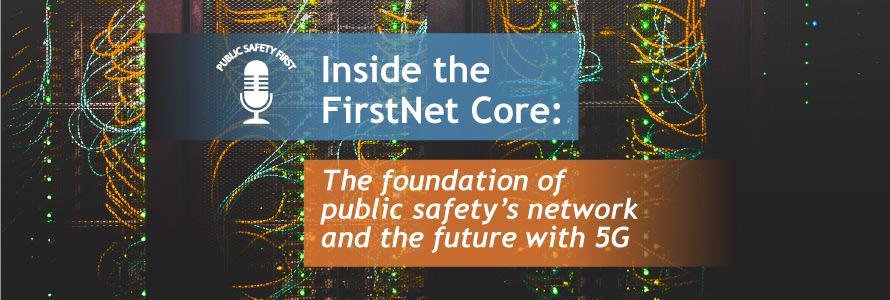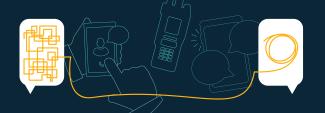Summary
To celebrate the second anniversary of the FirstNet Core, Carlos L’Abbate, FirstNet Authority Senior Director of Product Technology and Architecture, and Chuck Shaughnessy, FirstNet Authority Senior Advisor join host Dave Buchanan, FirstNet Authority Director of Public Safety Advocacy, to discuss how the Core was built for public safety and how it will continue to evolve to meet the needs of first responders.
Guest
Dave Buchanan
FirstNet Authority Executive Director of Public Safety Advocacy
Carlos L’Abbate
FirstNet Authority Senior Director of Product Technology and Architecture
Chuck Shaughnessy
FirstNet Authority Senior Advisor
Transcript
Preview
Narrator: You're listening to Public Safety First, a podcast to help you learn about the First Responder Network Authority and how you can be part of the future of public safety technology.
And now, your host.
Dave Buchanan: Hi, this is Dave Buchanan, and welcome to the Public Safety First podcast. The podcast you’re about to hear is part of our Roadmap podcast series, which provides more information about the FirstNet Authority Roadmap – our guide to the future of FirstNet.
As part of this series, we’re showcasing the six domains that provide the foundation for the Roadmap. Today’s episode dives into the Core domain, which focuses on how to enhance the FirstNet network core so that it can support the evolving mission-critical services and capabilities that public safety needs.
Narrator: You're listening to Public Safety First, a podcast to help you learn about the First Responder Network Authority and how you can be part of the future of public safety technology.
And now, your host.
Dave Buchanan: Hi, this is Dave Buchanan, and welcome to the Public Safety First podcast. The podcast you’re about to hear is part of our Roadmap podcast series, which provides more information about the FirstNet Authority Roadmap – our guide to the future of FirstNet.
As part of this series, we’re showcasing the six domains that provide the foundation for the Roadmap. Today’s episode dives into the Core domain, which focuses on how to enhance the FirstNet network core so that it can support the evolving mission-critical services and capabilities that public safety needs.
In today’s episode, I’m joined by two guests and experts on the Core: Carlos L’Abbate, Senior Director of Product Technology and Architecture at the FirstNet Authority, and Chuck Shaughnessy, Senior Advisor and Lead on the Roadmap Core domain at the FirstNet Authority. Thank you both for joining us today. Welcome to the podcast!
Carlos L’Abbate: Thank you.
Dave Buchanan: I’m going to start with you, Carlos. So, tell me a little bit about how you got to FirstNet. When did you start, and what is your job here?
Carlos L’Abbate: Carlos L’Abbate: I work in the CTO group. The most important part of my job is Core network and mission-critical services – the architecture and design portions of it, and we work together with AT&T to make sure that the, what is implemented in terms of the Core, as well as mission-critical services for public safety, meets the public safety needs, meets standards requirements and specifications, and it extends the life of our investment as much as possible. So, that’s one portion. The second portion is the work we’re doing on the Roadmap, which, is how that Core network looks like in the future when you’re getting to 5G. I came to work for FirstNet as a consultant a few years back. I worked for Nextel International before, and so it was a very natural evolution in my career to join FirstNet.
Dave Buchanan: Chuck, tell me, what do you do in your job at FirstNet, and how does it relate to the Core?
Chuck Shaughnessy: Well, I’m a Senior Technical Advisor for the CTO [Chief Technical Officer], and my job is, really to keep my finger on the pulse of all things technical going on at FirstNet. My background and most of my career has been in the LMR [land mobile radio] industry working for one of the major vendors there, so I’ve been in public safety communications my whole career. I’m also the leader of the Core domain as part of the Roadmap team, and a number of other areas I focus on, like mission-critical push-to-talk, coverage, coverage analysis, and things like that.
Dave Buchanan: Let’s get started, Carlos, with some level setting. For folks listening who don’t know a lot about broadband networks and LTE [long-term evolution] networks, can you describe what the Core is? What is the Core, and its relationship to the network, and why is it important to FirstNet?
Carlos L’Abbate: Sure, Dave. The Core is a computer-based system that serves as the brain and nervous system of a broadband network – like FirstNet. The Core connects a variety of elements: the radio access network – the LTE radio access network we have, as well as other radio access networks – and the devices that are connected to these networks. Phones, computers, tablets, and now migrating to Internet of Things [IoT] like streetlights, appliances, and other devices. So, when you’re using your smartphone, the Core is the reason you can make a phone call, send photos, texts, use apps, and everything else.
Dave Buchanan: So, let’s talk about the FirstNet Core. It’s now March of 2020, we’re celebrating the two-year anniversary of the FirstNet Core. Why is the FirstNet Core important for public safety services?
Carlos L’Abbate: So, the FirstNet Core is the first-ever nationwide LTE enhanced packet core, which is the official name of the Core, infrastructure that was built specifically for first responders. It is enhanced with features that were devised specifically for first responders’ use cases. So, the FirstNet Core is built on physically separate, dedicated infrastructure. So functions that are specific to public safety, that require special treatment, are physically separated, dedicated. It is also geo-redundant, meaning that it’s geographically distributed, which means that, if one data center that hosts the Core is down for any reason, others can take over, which improves the resiliency of the network.
Dave Buchanan: And is there one location for a Core? Is there –
Carlos L’Abbate: Various locations in the country, as well as for areas outside of continental U.S.
Dave Buchanan: It’s a separate, physical asset in a series of locations that allows our FirstNet network to perform the way that first responders expect it to perform.
Carlos L’Abbate: Correct, correct.
Dave Buchanan: So, tell me more about how the FirstNet Core makes it possible for those public safety features to perform. Like priority and preemption – how does having a separate physical core make that possible, and why is that important for first responders?
Carlos L’Abbate: The FirstNet Core recognizes and differentiates and separates all public safety traffic, and this is one of the key functionalities of the FirstNet Core is to provide separate treatment – special treatment – to public safety users. When there is congestion in the commercial network, there is no congestion for public safety because of the features of quality of service and preemption. Preemption is only enabled for first responders, and preemption is one of the most powerful features of a Core network. It can actually allow the Core to take people out of the network to serve public safety when there is a need.
Dave Buchanan: So, with respect to preemption, Carlos, I know our Boulder Lab allows visitors to come and see how we can compare commercial networks against traffic on the FirstNet Core. Talk about what they might see and how that shows up – how preemption would show up in that environment.
Carlos L’Abbate: Yes. So, our capability in the lab enables users to see, real time, two types of communication. One that is based on commercial network, the other one that is based on FirstNet with quality of service and preemption. And what you see is that as traffic increases, one side – the commercial side – starts showing slow throughput, or even inability for the user to access the network. While, on the FirstNet side, as traffic increases, what you see is that users that don’t have the highest level of quality of service and don’t have preemption capabilities will stay on the network as others are shed out of either sites or multiple cell sites.
Dave Buchanan: And, of course, if you’re a first responder and a FirstNet customer, you don’t have to go to Boulder to see that. You can see that any day using your own device as a public safety professional. So we’ve heard at Public Safety Advocacy as we do our work out in the field, every day about how beneficial this priority and preemption that comes from our Core network really can be for public safety.
Carlos L’Abbate: Yeah, I agree. The best way to describe it, I would think, is it is a uniform experience. A person can be alone at two in the morning on a cell site and use the system as well as in the stadium with many thousands of people – the experience of the public safety user will be the same.
Dave Buchanan: So, let’s talk about security and what kind of benefits would public safety get if they’ve got security concerns about using the network – how does the Core change that environment for public safety?
Carlos L’Abbate: Security is a foundation of everything we do, not only from a Core perspective, but radio access and devices as well. FirstNet has a dedicated Security Operating Center, SOC, as well as a dedicated Network Operating Center, NOC, and that’s 24/7. That guarantees that everything that is FirstNet is treated by specific dedicated systems, as well as dedicated personnel.
Dave Buchanan: So, the Security Operations Center and the Network Operations Center are looking at an overview of the security and network operations at the Core network – they’re monitoring that, managing that?
Carlos L’Abbate: Monitoring, managing, proactively detecting problems that they see, not only from the FirstNet network, but from other networks. So, any threats they can proactively prevent. And the fact that it is dedicated is extremely important, because you have people that pay attention only to what goes on on the FirstNet network.
Dave Buchanan: So, you hear a lot about, when people talk about networks, you hear about the cloud, you hear about virtual cores. Tell us why FirstNet’s current design of our separate physical Core is unique and important, and how are we preparing for the evolution of core architecture?
Carlos L’Abbate: So, let’s start with the FirstNet core as it is today. It was built from the ground up to meet public safety needs. The physically separate infrastructure that it’s built on, it’s completely dedicated to FirstNet subscribers. Enterprise networks – they are largely virtualized today, and most major businesses rely on existing cloud infrastructure to operate their networks. However, telecommunications networks – they’re not migrating at the speed of enterprise to virtualized functions. So, this migration is happening slowly, but we see that AT&T is a leader in doing this, and we can leverage AT&T’s knowledge and experience on the use of software to improve security, reliability of the first responders’ network. It also allows us to keep parity with industry, which is very important.
Dave Buchanan: I know we invested in a separate, physical core. Why didn’t we choose to go with a cloud direction or a virtual core?
Carlos L’Abbate: Excellent point. We couldn’t. The technology’s not, was not mature enough when we implemented our core. One of the things that we’re doing that is very important for public safety is we’re not at the cutting edge of technology. When you are at cutting edge of technology, it looks cool, but there are many bugs, there are problems, there is outages – we don’t want that. So, we want always to be at a point where the technology is mature enough to support public safety mission-critical types of communication.
Dave Buchanan: Well, thank you Carlos, for providing that overview of where we are today with the Core network. It was very helpful. Chuck, I now want to move to you and have a conversation about where we’re going in the future. You’re leading our Roadmap efforts related to the Core. We’ve had previous podcasts about the Roadmap, but can you start by telling us what the Roadmap is and how it was created, and why is it important for first responders?
Chuck Shaughnessy: Thanks, Dave. The Roadmap is, it comes across as quite complex, but it’s really, simply, a document that’s technologically focused that looks into where should FirstNet be taking the network as we move forward and evolve it.
Dave Buchanan: And so, tell us a little bit why the Core was included in the Roadmap.
Chuck Shaughnessy: Well, as Carlos said, the Core is really the nervous system of the network. It’s the centralized switch, it ties everything together, it makes the decisions, it keeps track of where people are and when users are logging on and logging off, it provides a lot of security, it provides handoff from one site to the other as people roam, and many of the technologies that a user uses every day, like mapping, voice calling, data services – those are all services that are enabled by the centrality of the Core and the technology in the Core. So, while the Core is not something that people routinely talk about, of the Core worked today or didn’t work, it really is an enabling technology for all of the things that people use every day. So, fundamentally, it’s underneath what everyone sees, and we thought it was important that it be just at the forefront of where we put our energy, and our time and our money as we evolve the network forward.
Dave Buchanan: I know we’ve put some emphasis on staying current with the latest technology. What does that technology look like in the future for us with respect to the Core?
Chuck Shaughnessy: The Core today, as Carlos talked about, is built on 4G technology, or LTE technology. AT&T built it from the ground up with public safety in view, with a dedicated infrastructure in place to really enable some specific mission-critical functionality that public safety finds critical, as well as the other generic functionality that cores typically do. Everyone hears it in the news – the next generation from 4G is 5G. It’s starting to be implemented around the world.
As you know, Dave, last fall, the Board approved that the FirstNet staff pursue the beginnings of an investment process for understanding and laying the groundwork for making the network “5G ready.” We’ve spent a lot of our time and a lot of energy of really understanding the basics of 5G technology, what does it do for public safety, how can we implement 5G technologies in what public safety uses every day, and how to start the process of evolving our network from 4G to 5G. We’re in the middle of a procurement process with that and we see a lot of advantages of 5G when it actually gets here.
Dave Buchanan: So let’s talk about 5G. Why will it be important for public safety, Chuck?
Chuck Shaughnessy: Well, there’s a couple of answers to that, Dave. The first one is that’s the trend of technology worldwide – not only our partner, but every major carrier in the world has started implementing 5G in some aspects. They’re moving their networks and evolving them from 4G to 5G. So, primarily, we have a mandate, and we think it is strategically important to maintain parity with commercial capabilities. The commercial world and its capabilities are moving towards 5G, so it’s important that we do that, as well.
Now, the second part of the answer is there are some technologies that 5G enables that will be important to public safety. And there’s really four real key things that make 5G different from 4G. The first is the spectrum available. The standards bodies and the FCC [Federal Communications Commission] in the U.S. have made millimeter wave spectrum available to 5G, which is above 24 gigahertz – it’s very high frequency. Its propagation doesn’t go very far, but the bandwidths are really wide, and you can get very, very fast data rates. So, there’s a whole new spectrum opening up for 5G that makes very fast data rates available to its users. That’s one thing.
The second thing is the network capacity increases greatly from what we have in 4G. And this makes IoT possible – massive IoT – where we can connect lots of things to the network. Just for reference, the 4G networks can put tens of thousands of devices in a square kilometer on the network. The 5G network can put millions of devices in a square kilometer on the network.
The second thing is what’s called improved latency, and latency is how fast does the network respond when you ask it to do something. And it really is a function of how close you are to the physical assets. One of the things 5G does is it breaks the Core into more pieces, moves the content much closer to the user, so when users ask the network to do things, it responds probably in order of magnitude faster than what we’re seeing with 4G today. So, improved latency is a big deal.
So, the user will see improved data rate – which means things go faster; improved latency – which means the network responds faster; massive IoT capabilities – meaning we can put a lot more things on the network; and access to new spectrum that we never had before. Four big things that make 5G important. And there are many use cases we anticipate coming forward, that will make public safety’s job much easier to do and be a great benefit to first responders.
Dave Buchanan: So – ultra-low latency and massive adoption and use of Internet of Things – it’s not hard to understand public safety use cases and how they can be used to bring about a, really, a revolution of opportunities for public safety with the advancement of this technology.
You know, we’ve spent a lot of time now talking about 5G. I understand, and I think our listeners can really appreciate why 5G and its evolution is critically important for FirstNet and the first responders who use the service. But tell us again why we’re talking about it within the context of the Core.
Chuck Shaughnessy: As Carlos highlighted earlier, the Core is really the brain or the nervous system of the network. So, to get to some of these 5G capabilities, the Core has to be evolved with the rest of the things. There will be new devices, as well. There’ll be new base stations that are at the cell tower sites that are 5G specific, so all of these things have to evolve and change and improve with technology in order to take full advantage of the 5G capabilities. But the Core has to go first. You have to have the Core in place before you can really take advantage of the technology in the hands of the user. So it’s really central, as we said, foundational to our Roadmap and to where the network evolves, and we’re treating it that way. It’s important, and it is near the front of the line for investment dollars when we start thinking about where we’re moving.
Carlos L’Abbate: To add to what Chuck said, the way to think about this is – this is a system of many components. And when you want to build new functionalities on that system or for that system, you start building from the Core, and then it spreads out to other elements of the system.
Dave Buchanan: I mean, the story here for public safety is also – even though you can’t see it and nobody thinks about it, it really is the most important part of what makes our public safety network, a public safety network.
Well, this has been terrific, thank you, Carlos, and thank you, Chuck, for spending time with us today. Again, thank you listeners for continuing to join us on this conversation about our Roadmap and the future of FirstNet. We look forward to bringing these engagements to public safety through our Public Safety Advocacy team, and we’re going to continue to use this podcast series as a way to share that discussion and share information with you about the future of FirstNet, the use of our Roadmap, and how we’re using public safety’s feedback and inputs to shape the future enhancements, improvements, and investments in FirstNet. Thank you for listening.
Narrator: Thanks for listening today. We're excited to have you join our podcast community. Make sure to subscribe on iTunes, SoundCloud, and YouTube. You can learn more about the First Responder Network Authority at FirstNet.gov and learn about FirstNet products and services at FirstNet.com.























